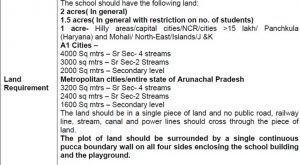- Minimum Area Requirement
As per the Indian Standards you can start a school in India if you have 2 acres of land parcel. The land requirement can change depending on where the land is located: urban or rural. Below is the minimum land requirement prescribed by CBSE. The same is available to download on the website of CBSE. www.cbse.nic

The land ownership must be under the name of the school or a trust/ society/company or else it should be leased for a minimum of 30 years to the trust by a governmental agency.
The minimum land required for obtaining the approval for a school (Class 1 to 12) within the Municipal limits of Capital city and Tier 1 Cities is 1 Acre. But for schools from class 1 to X the approval is possible even in lesser areas upto 0.5 acre. While in other rural areas the minimum land requirement is 2 Acres for obtaining necessary affiliation.
- Land Use
Before buying the land cross check the land use of the plot as per the Town Planning authority. If the land use says an agriculture of industrial plot, you will need to get the Change of Land Use (CLU) to for ‘education purpose’ after purchase. You will need to approach the land revenue office for the same and the process might take a time of three to six months. It is always advantageous to prepare a Master Plan before you apply for CLU as this would give you clarity on the building arrangements and maximum occupancy you can achieve and hence your investment vs. ROI. You can download the application form for Change of Land Use from here.
- Feasibility Study
Before deciding on buying the plot, you will need to do a demographic study of that particular locality to understand the population density, the people and their beliefs, education status and most importantly the paying capacities. India being a country of diversities the challenges in different localities would vary. Make sure that the land identified is one single piece as the affiliation does not permit two separate land parcels in the same vicinity. No public road, railway line, stream, canals or power lines should cut across the land. A 5 km radius of the site need to be thoroughly studied for the presence of any polluting factories or any activity that can later pose a threat to the functioning of a school. Also check for drains or any water bodies that can create a security concern for the safe movement of children within the site premises.
- Frontage and Accessibility
Make sure the selected land has sufficient frontage and easy accessibility from the main road or city. As these factors helps in image and brand building of the school. Even a smaller chunk of land towards the front for road access and the rest majority of land towards the back also helps. Though, ideally the school has to be in a silent and peaceful zone away from the hustle and bustle of the city, this might not work very well in the Indian towns, because of the lack of proper access roads and safety concerns of parents.
- Suitability for Construction purposes
A validation of the suitability of land for construction purposes is inevitable. A site with favorable soil conditions would considerably reduce the foundation cost during the time of construction. In general, a site which is rectangular in shape is the best suited for utilizing every inch of land in the most effective manner. Irregular shaped sites can create corners and unsafe areas out of the visibility of the concerned authorities which can raise a security concern for children.
- Future expansion possibilities
Indian cities and towns are continuously growing or expanding, and the trend have been that people tend to move out of the congested city centres for better living conditions. Hence, the location of the site can be validated with respect to the growth possibilities of the cities. Verify if the site has future expansion possibilities of neighboring vacant lands which can be purchased as and when required. A master plan can be prepared in phases to plan for the future developments. A school can have 3 phases of expansion in its life time and beyond which you will need to purchase a new land for a new establishment.

